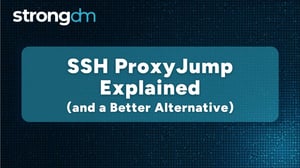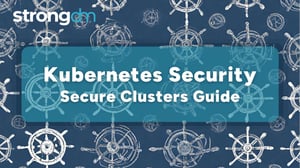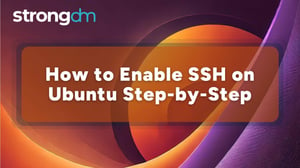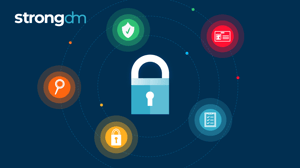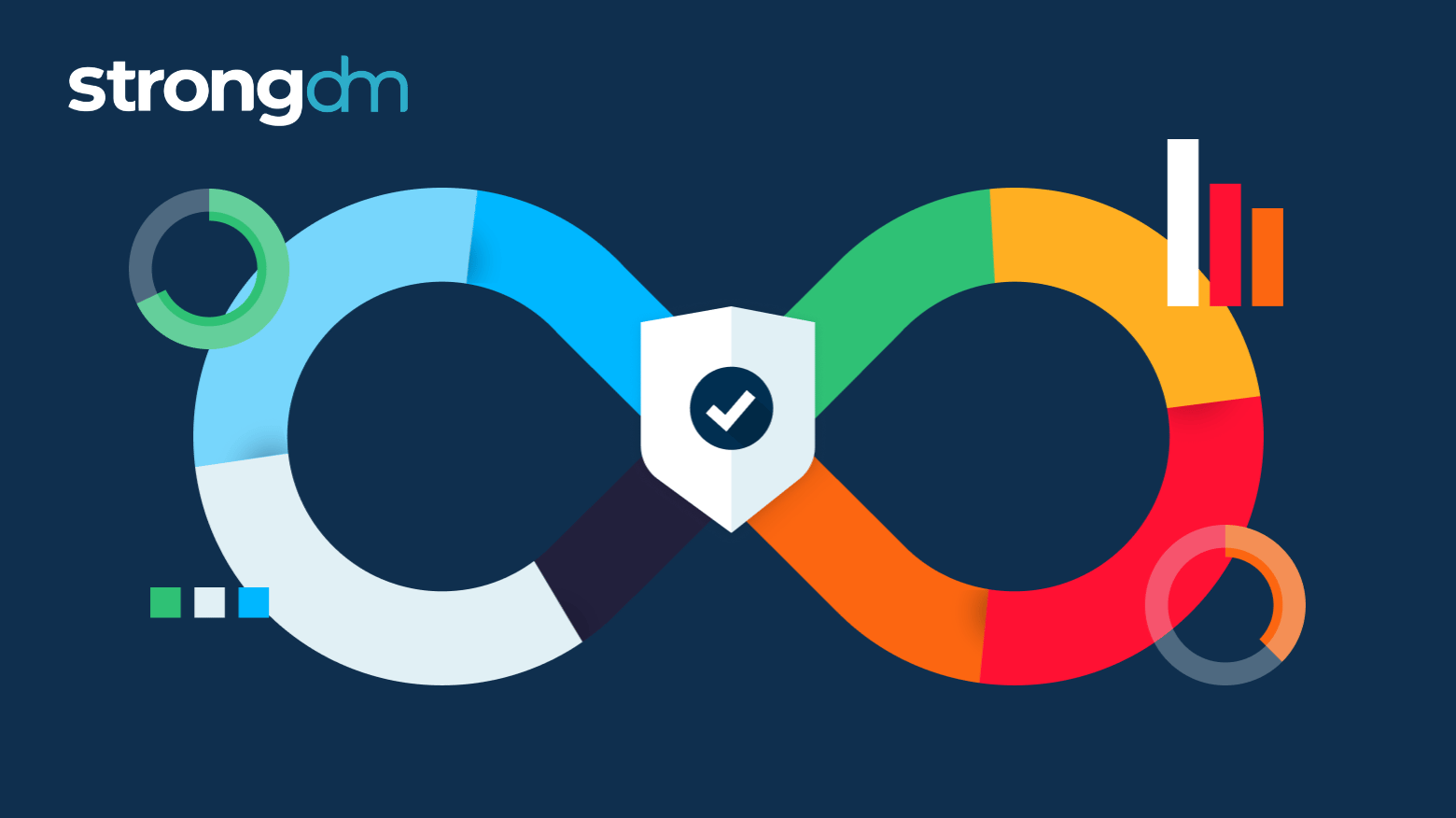

Written by
John MartinezLast updated on:
October 6, 2025Reading time:
Contents
Built for Security. Loved by Devs.
- Free Trial — No Credit Card Needed
- Full Access to All Features
- Trusted by the Fortune 100, early startups, and everyone in between
DevSecOps means building secure software fast. But securing every layer of your stack, from code to containers to cloud infrastructure, takes more than patching vulnerabilities or running static scans. You need a coordinated toolkit.
This guide breaks down the eight must-have DevSecOps tools and how they work together. You’ll learn what each tool protects, where it fits in the SDLC, and most importantly, how to tie it all together by securing access to your infrastructure with Zero Trust and least privilege. Because if your stack isn’t locked down at the access layer, your other defenses don’t matter.
1. StrongDM: Infrastructure & Access Control
What it does: StrongDM manages access to critical infrastructure, such as servers, databases, Kubernetes clusters, and internal web applications. It enforces Zero Trust and the principles of least privilege (PoLP), ensuring that only authorized individuals (and services) have access, without requiring shared credentials, VPNs, or SSH keys.
Key features:
- Centralized access control: StrongDM consolidates access into a single control plane, allowing administrators to assign permissions based on defined roles. This is crucial for expediting the deployment process, particularly in DevSecOps, where speed is a key factor. Developers and team members can access what they need quickly, and only when and if they need it to perform their duties.
- Automatic session recording: StrongDM records every session in real-time, in an immutable form, ensuring that it cannot be tampered with. Additionally, these logs make it easy to know who accessed what and when.
- Seamless integration: With StrongDM, you can easily enforce the same security standards across different environments, as it seamlessly integrates with hybrid, cloud, and on-premise environments, creating a unified access framework.
- Zero Trust and least privilege enforcement: StrongDM implements Zero Trust with its Cedar-based policy engine, allowing administrators to create and enforce fine-grained access controls. It also supports PoLP, which enables system administrators to grant users only the necessary access to perform their tasks, and only for as long as they need it.
Use cases:
- Onboarding and offboarding engineers without manual credential handoffs: StrongDM lets you automate these processes. When an individual joins your organization, they’re instantly granted access based on their roles. When they leave, StrongDM automatically revokes this access. This automation aligns with the DevSecOps principle of security, which supports fast-moving development.
- Meeting compliance requirements: To achieve compliance with security standards like HIPAA, SOC 2, or ISO 27001, you must have logs ready for auditing purposes. With automatic recording features, it's not an issue.
- Enabling secure remote access to sensitive infrastructure: StrongDM supports the distributed nature of DevSecOps teams by replacing risky and outdated access methods, such as static credentials and VPNs, with single sign-on (SSO) access. This allows team members to log in once, while least-privilege and Zero Trust policies work behind the scenes.
Why it fits DevSecOps: DevSecOps is based on embedding strong security controls into the development lifecycle without slowing teams down. StrongDM fits this model by automating and centralizing secure access. It enforces Zero Trust and least privilege, so that only authorized people can access critical infrastructure. Its centralized control plane and immutable logs make visibility and compliance preparation seamless.
Case study: How Coveo centralized access with StrongDM
When Coveo, a market-leading AI-powered relevance platform, began operations in 2005, it had only one database in a single region. The databases expanded as the platform grew into other areas and became a multi-regional company. The expansion made managing access rights difficult. For instance, if a privileged employee needs access to 100 databases, they would require 100 separate credentials. It was clear that the situation required a better access solution.

While the company developed an in-house solution and even explored third-party solutions, each tool only addressed part of the problem. Coveo needed a comprehensive tool, and StrongDM was the answer because it met the needs for both security and simplicity.
Coveo then began using StrongDM to centralize the login process for employees and manage access. During the onboarding process for new employees, StrongDM provides a single credential to access the necessary databases. This has also reduced the administrative burden on DevOps teams, allowing them to focus on other top-priority projects.
The result: StrongDM helped Coveo meet requirements for HIPAA, SOC2, and security analysis compliance. Because of StrongDM’s audit logging feature, Coveo can easily determine what happened, when it happened, and who was responsible in the event of an incident. Read the full Coveo story.
2. Snyk: Source Code & Dependency Security
What it does: With Artificial Intelligence (AI) as its foundation, Snyk continuously scans for vulnerabilities in open-source libraries, containerized environments, and infrastructure-as-code (IaC). It provides actionable remedies for your development team, allowing them to resolve issues on the go. It also automates fixes and upgrades that teams can apply quickly and efficiently. This shifts security left—it becomes a proactive part of development rather than a reactive audit.
Key features:
- Deep ecosystem integration: Snyk seamlessly embeds security into every stage of the SDLC, from IDEs (VS Code, IntelliJ) to source code management, CI/CD pipelines, and container registries & Kubernetes. It provides accurate and fast scanning without disrupting developer workflows.
- Continuous scanning: While Snyk scans for vulnerabilities on demand, it also continuously monitors connected repositories, Kubernetes deployments, and container registries for new vulnerabilities, including those newly disclosed in existing dependencies.
- Real-time alerts with prioritized fixes: When Snyk detects a threat, it sends a real-time alert to the developer, prioritizing the necessary fixes. It also provides remediation guidance and automated fixes for developers to implement, which expedites the development process.
Use cases:
- "Shift-left" dependency vulnerability management: Your security team doesn’t have to discover vulnerabilities way into production or a few stages before a release. With Snyk, developers receive alerts at every stage of development to address potential risks. These alerts reduce the development time (because the context is still fresh) and remediation costs.
- Secure container image builds: You can integrate Snyk directly into container build pipelines, allowing it to scan the resulting image against a known-vulnerability database. Snyk can identify and fix any insecure photos before they reach deployment.
- Enforcing IaC security policies: Snyk IaC detects misconfigurations, such as overly permissive security groups or publicly exposed S3 buckets, before they are deployed, preventing cloud security failures. It achieves this because it scans Kubernetes YAML files, Terraform, and other IaC templates.
💡How StrongDM complements it: Snyk secures the “what,” while StrongDM secures the “who” and “how.” Snyk secures your codebases and dependencies. It ensures that the artifacts you’re building and deploying are inherently secure and free from known vulnerabilities. On the other hand, StrongDM ensures that only the right people (and machine identities) can access the environment where the code runs.
3. Checkov: CI/CD Pipeline Security
What it does: Checkov is an open-source project designed to secure IaC for security misconfigurations before deployment. It utilizes a familiar command-line interface (CLI) to analyze IaC scan results across CloudFormation, Terraform, Azure Resource Manager (ARM) templates, Kubernetes manifests, and serverless configurations.
This DevSecOps tool works by comparing your IaC files against its library of policies—logical rules that check for specific security best practices or compliance requirements. It embeds guardrails directly into the CI/CD pipeline. This makes it easy to catch insecure configurations early and avoid costly reworks later in the SDLC.
Key features:
- Broad IaC support: Checkov provides security across diverse tech stacks, supporting scanning for ARM, CloudFormation, Serverless, Terraform, and more.
- Policy-as-code enforcement: It prevents misconfigurations from slipping through by codifying and automatically applying security and compliance policies.
- Easy integration with CI/CD pipelines: Checkov integrates seamlessly with multiple CI/CD platforms, allowing for smooth operation without disrupting existing workflows. These include Jenkins, Bitbucket Cloud Pipelines, GitLab CI, and GitHub Actions.
Use cases:
- Preventing common cloud misconfigurations: Checkov automatically catches and blocks misconfigurations in S3 buckets, overly permissive IAM roles, and insecure Kubernetes YAML files before deployment.
- Enforcing compliance standards automatically: Embedding Checkov in your pipeline can help your organization meet compliance with common frameworks, such as PCI DSS or SOC 2. Checkov converts security requirements into policy-as-code rules, enabling continuous compliance checks.
💡How StrongDM complements it: Checkov allows only secure configurations to reach production environments. Once deployed, StrongDM manages access by allowing only authorized persons and services to interact with the configurations.
4. Aqua Security: Container & Runtime Security
What it does: Aqua Security provides continuous protection for applications in containerized and Kubernetes environments. Unlike other DevSecOps tools, such as Snyk and Checkov, which secure code and infrastructure before deployment, Aqua Security protects applications throughout their entire lifecycle—from code commit to runtime.
Key features:
- Vulnerability scanning and supply chain security: Before deployment, Aqua Security scans images in registries, including during the CI/CD process. It goes beyond detecting Common Vulnerabilities and Exposures (CVE) and identifies misconfiguration, hidden malware, and embedded secrets.
- Runtime protection against active threats: Aqua protects container workloads using behavioral monitoring, drift prevention, and rules-based policies to detect and stop attacks in real-time with the least impact on the production environment.
- Policy enforcement: With Aqua, you can define granular assurance policies for container runtimes and Kubernetes clusters, so that only compliant workloads can run.
Use cases:
- Preventing untrusted containers from running: Aqua prevents the deployment of containers built from base images with critical vulnerabilities or those that haven’t undergone proper scanning. It enforces image assurance policies, which act as gatekeepers before images are deployed to production.
- Enforcing compliance in dynamic environments: If your organization runs Kubernetes, you're aware of the challenges in maintaining a compliant state due to constant change. Aqua can help you achieve compliance by continuously auditing cluster configurations and running workloads against security benchmarks. It also provides ongoing assurance and automatic remediation for misconfigurations.
- Detecting malicious activity inside production clusters: Runtime threats can emerge from exploited vulnerabilities, even if you have a secure supply chain. Aqua’s runtime security monitors how an application behaves to detect any indicators of an attack, such as a web application suddenly attempting to run a cryptocurrency miner. When identified, Aqua then automatically kills the malicious container.
💡How StrongDM complements it: While Aqua focuses on what the containers do at runtime, StrongDM controls who can authenticate and access the Kubernetes API, nodes, or underlying databases. Together, they provide your DevSecOps team with runtime visibility and infrastructure-level access control.
5. HashiCorp Vault: Secrets Management
What it does: HashiCorp Vault is an identity-based secrets and encryption management system. While it acts as a secure and encrypted store for static secrets, it also generates dynamic secrets. It manages tokens, APIs, and certificates.
Key features:
- Short-lived credentials: Vault can generate unique usernames and passwords on demand for each unique user, application, or machine, with a short time-to-live. It eliminates the need for a static database for passwords.
- Encryption as a service: Vault can help reduce the workload of your developers by taking over encryption and decryption tasks. It can change plaintext data from applications into hashes and HMACs, without embedding encryption logic into the codebase.
- Fine-grained access policies (policy-as-code): Vault helps enforce the principle of least privilege programmatically through its policy-based access controls. Written in HashiCorp Configuration Language (HCL), these policies govern access to secrets and the operations that users can perform.
Use cases:
- Automatic database secret rotation: With Vault, you can reduce the security risks associated with manual secret rotation in databases. This tool can help you rotate passwords for database users without any application downtime.
- Kubernetes secrets: In Kubernetes environments, secrets such as passwords are often shared across multiple pods and services, inadvertently increasing the attack surface. With Vault, each service or pod can authenticate to Vault and request its own dynamic credentials on demand.
💡How StrongDM complements it: HashiCorp Vault secures the sensitive credentials of an application, while StrongDM secures and manages the people and services that use those credentials.
6. Wiz Code: Code-to-Cloud Security
What it does: Wiz Code helps DevSecOps teams catch risks early in the development lifecycle. It scans infrastructure-as-code, containers, and open-source dependencies for misconfigurations, secrets, and vulnerabilities, and connects those findings to runtime context using the Wiz Security Graph. This gives teams the ability to prioritize issues that actually matter in production rather than chasing noise.
Key features:
- IaC security: Scans Terraform, CloudFormation, Helm, and other IaC templates for misconfigurations before they’re deployed.
- Supply chain protection: Identifies vulnerable packages, secrets, and hardcoded credentials in code and CI/CD pipelines.
- Contextual prioritization: Links code-level findings to runtime cloud context (via Wiz’s CNAPP) to focus remediation on real risks.
- Developer-friendly workflows: Integrates with CI/CD pipelines, GitHub Actions, and developer IDEs to surface security feedback where engineers work.
Use cases:
- Preventing insecure cloud infrastructure from being deployed.
- Reducing noise in code scanning by showing which vulnerabilities are exploitable in production.
- Enforcing “shift-left” compliance with automated checks in CI/CD.
💡How StrongDM complements it: Wiz Code uncovers risks in code and cloud configurations, while StrongDM ensures secure, just-in-time access to the infrastructure where that code runs. Together, they give DevSecOps teams both proactive security and strong access controls across the lifecycle.
7. Cedar: Fine-Grained Access Control
What it does: Cedar is an open-source policy language developed by AWS that defines and enforces who can perform what actions on which resources and under what conditions, by separating authorization logic from application code.
Key features:
- Simplicity: The language is intentionally clear and resembles natural language, allowing developers and non-technical individuals to write, audit, or review it with ease.
- Open-source: Although the language is the engine behind AWS Verified Permissions and Amazon Verified Access, it’s open to community adoption and innovation.
- Policy-based: Cedar policies specify the conditions under which applications can allow or deny user access. These rules also include conditions that assess the attributes of the resource in question, the principal, and the context of the request.
Use cases:
- Enforcing fine-grained access in multi-tenant SaaS platforms: For SaaS applications that require strict isolation between tenants, Cedar can be a valuable solution.
- Embedding authorization logic into applications or services: You can integrate the Cedar engine into your service mesh or individual microservices to create a consistent and centralized authorization layer across the entire application architecture.
- Creating context-based rules: With Cedar, you can create precise rules that adapt to the situation at hand. For instance: “Grant access to X only if the user is in the Y group, their account is in the X region, they’ve completed MFA, and the access attempt occurs between 2 AM and 2 PM.”
💡How StrongDM complements it: When used together, StrongDM and Cedar provide comprehensive control across the full stack. StrongDM manages who gains access to the systems that run an application, while Cedar controls what a user can do within the app. Learn more.
Honorable Mention:
OpenFGA (by Okta): OpenFGA is another open-source, fine-grained authorization system that enables security teams to create granular access controls. It utilizes an easy-to-read yet powerful modeling language that’s accessible to both engineers and non-technical users.
Unlike Cedar’s policy language approach, OpenFGA’s approach is graph-based. It allows you to model and enforce authorization by defining the relationships between objects (such as documents, folders, and servers) and users. Instead of writing complex policy rules, you define a schema that describes these relationships, and the engine answers authorization queries by traversing this graph.
8. Datadog: Monitoring & Threat Detection
What it does: Best known as an observability platform, Datadog extends this capability into the security domain. It combines performance monitoring and threat detection into a unified platform, collecting, correlating, and analyzing security events across the entire stack in real-time to detect threats.
Key features:
- Unified security & performance data collection: Datadog can ingest data from hundreds of integrated sources, such as logs, traces, and metrics, into a single platform. This provides security alerts with context from the underlying systems, making it easier to investigate and remediate.
- Cloud-native SIEM with out-of-the-box detection rules: Datadog comes with pre-built detection rules that help identify common threats such as cloud misconfigurations, data exfiltration, and cryptojacking.
Use cases:
- Monitoring for unusual API activity: Datadog can detect and alert you about suspicious API calls by analyzing logs, such as when a user attempts to delete several EC2 instances.
- Detecting brute-force login attempts: If a pattern of login failures from a single IP address targeting multiple user accounts is detected, Datadog can trigger an alert.
- Combining performance and security visibility: Datadog works by correlating performance anomalies with security events to provide a comprehensive view of both. For instance, if a container suddenly starts using over 90% of its CPU, Datadog can connect this with a security issue. Datadog will then flag it as a high-priority incident.
💡How StrongDM complements it: In the event of suspicious activity, Datadog can quickly alert security teams. StrongDM then steps in and provides a detailed audit trail to show precisely what happened, when it happened, and who accessed what.
Building Your DevSecOps Stack
To successfully adopt DevSecOps in your organization, you need a combination of complementary tools that secure every layer of your development and infrastructure stack. No single tool can do it all, but combined, they close the gaps that often lead to vulnerabilities.
For example, you can combine all eight tools we’ve discussed in this guide, where:
- StrongDM is the foundation that secures and audits access
- Snyk secures the code and open-source dependencies
- Checkov secures the infrastructure-as-code pipeline
- Aqua secures containerized environments at runtime
- Vault secures and rotates secrets
- Wiz Code connects code-to-cloud security, prioritizing real risks that matter in production
- Cedar enforces fine-grained policies across applications
- Datadog monitors performance and detects threats in real time.
Using these tools together enables security-first teams to build DevSecOps applications that meet both technical and compliance requirements with StrongDM as the access and control backbone, tying everything together.
Why StrongDM is the Backbone of Modern DevSecOps
Every high-performing DevSecOps team faces the same challenge: how to move fast without losing control. Security, compliance, and developer velocity often feel like trade-offs—but StrongDM eliminates the compromise.
StrongDM replaces the patchwork of VPNs, SSH keys, and static credentials with a unified access layer for all infrastructure: servers, databases, Kubernetes clusters, and internal applications. By enforcing Zero Trust and least privilege through a central policy engine, StrongDM ensures that every connection—whether from a human or a service—is authenticated, authorized, and auditable in real time.
Through access workflows and JIT (Just-In-Time) approvals, teams can grant short-lived access only when it’s needed, while automatic session recording and immutable logs provide continuous visibility and audit readiness. And because StrongDM is built on proxy clusters that scale elastically across hybrid and multi-cloud environments, you can centralize control without slowing down deployments or redesigning your network.
From securing production databases to controlling Kubernetes access and integrating with identity providers like Okta or Entra ID, StrongDM delivers the access foundation that every other DevSecOps tool relies on.
In short: StrongDM is the connective tissue of your DevSecOps ecosystem—automating access, enforcing policy, and simplifying compliance so your team can build, ship, and scale securely.
Want to unify security across your Dev, Sec, and Ops teams? Book a StrongDM demo to see access control that actually works in real life.
Next Steps
StrongDM unifies access management across databases, servers, clusters, and more—for IT, security, and DevOps teams.
- Learn how StrongDM works
- Book a personalized demo
- Start your free StrongDM trial
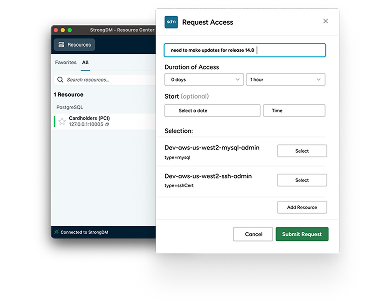
Categories:

About the Author
John Martinez, Technical Evangelist, has had a long 30+ year career in systems engineering and architecture, but has spent the last 13+ years working on the Cloud, and specifically, Cloud Security. He's currently the Technical Evangelist at StrongDM, taking the message of Zero Trust Privileged Access Management (PAM) to the world. As a practitioner, he architected and created cloud automation, DevOps, and security and compliance solutions at Netflix and Adobe. He worked closely with customers at Evident.io, where he was telling the world about how cloud security should be done at conferences, meetups and customer sessions. Before coming to StrongDM, he lead an innovations and solutions team at Palo Alto Networks, working across many of the company's security products.
You May Also Like
